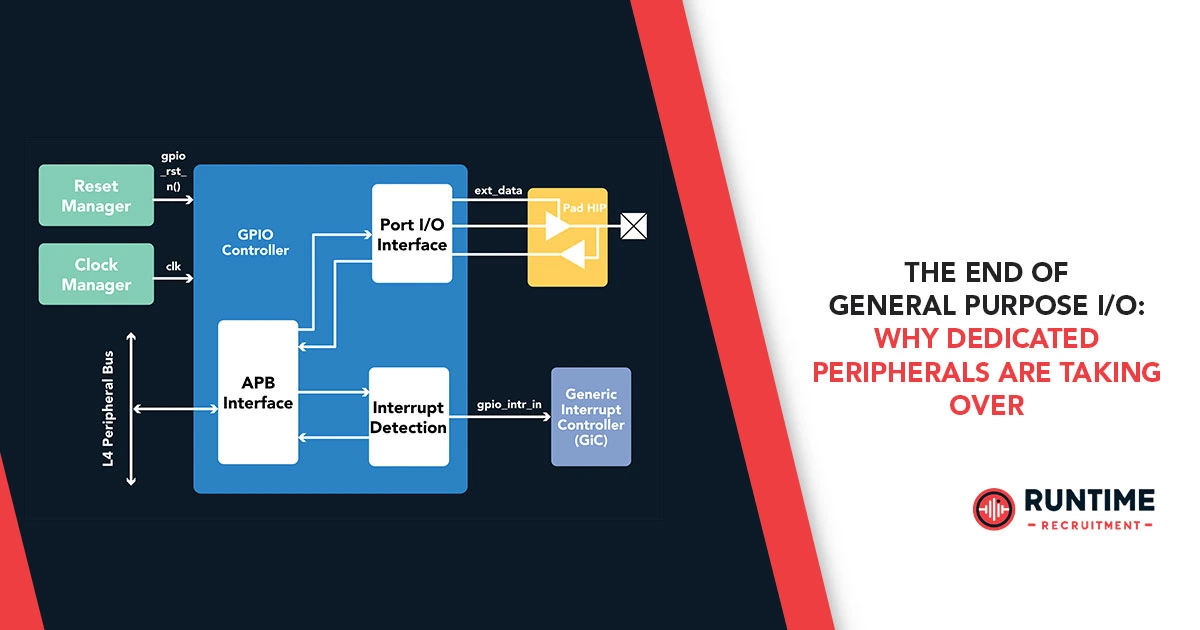Embedded systems are a world of constraints. We, as engineers, are constantly balancing a triad of competing forces: performance, power, and cost. For decades, the workhorse of this domain has been the General Purpose I/O (GPIO) pin—a simple, programmable digital pin that can be configured as an input or an output. It’s the Swiss Army knife of embedded design, capable of a little bit of everything.
However, in the relentless pursuit of efficiency and specialization, the era of the GPIO as the default solution is drawing to a close. A new paradigm is emerging, one where dedicated peripherals are no longer a luxury but a necessity, fundamentally reshaping how we design and build embedded systems.
From GPIO Juggling to Peripheral Powerhouses
Early microcontrollers were, by modern standards, barebones. The CPU was king, and most of the heavy lifting was done in software. Want to toggle an LED? Write a for loop to delay. Want to communicate over a serial protocol? Bit-bang it with GPIOs. This approach, while flexible, was incredibly inefficient. It consumed precious CPU cycles, was notoriously difficult to time accurately, and was prone to jitter and errors. This is the world of software-based I/O, a world of GPIO juggling where the CPU is a master puppeteer, constantly pulling the strings of individual pins.
As embedded systems grew in complexity, this model became a bottleneck. The CPU, burdened with mundane tasks like managing a simple serial port, couldn’t focus on the primary application. The solution? Offload these tasks to specialized hardware. This is the birth of the dedicated peripheral—a hardware block designed to perform a specific function with minimal or no CPU intervention.
| Feature | General Purpose I/O (GPIO) | Dedicated Peripherals |
| Functionality | Flexible; can be configured for a variety of tasks | Fixed; optimized for a specific task (e.g., UART, I2C, SPI, ADC) |
| CPU Load | High; requires CPU to manage timing, data transfer, and state | Low; handles tasks autonomously, often with DMA, freeing the CPU |
| Performance | Limited; prone to timing issues and jitter, and dependent on CPU speed | High; deterministic, reliable, and operates at hardware speeds |
| Power Consumption | Often less efficient due to constant CPU activity | More efficient as they can operate in low-power modes and wake the CPU only when needed |
| Ease of Use | Simple for basic tasks, but complex for high-speed or timed protocols | Requires initial configuration but simplifies the main application logic |
| Reliability | Susceptible to software bugs and timing inaccuracies | Highly reliable due to hardware-based operation |
This table neatly illustrates the shift. We’re moving from a system where we build functionality in software to one where we simply configure hardware blocks. This change isn’t just about making things faster; it’s about making them more reliable, more power-efficient, and more scalable.
The Unassailable Benefits of Dedicated Peripherals
The move away from GPIO-centric design is driven by a number of compelling, and in many cases, non-negotiable benefits.
1. Performance and Determinism
In many embedded applications, timing is everything. Think of a motor controller, a real-time audio processor, or a sensor reading system. A few microseconds of delay can mean the difference between a stable system and a catastrophic failure. Dedicated peripherals are designed to be deterministic. A hardware UART, for instance, can transmit data at a precise, pre-defined baud rate without a single CPU instruction once it’s configured. This is in stark contrast to a software-based serial port, which can be easily disrupted by an interrupt from a different part of the system, leading to corrupted data. The use of hardware accelerators, like Digital Signal Processors (DSPs) for signal processing or Floating-Point Units (FPUs) for complex math, are extensions of this principle, handling demanding computations with a speed and precision that would be impossible in general-purpose software.
2. Power Efficiency
This is perhaps the most significant driver in the age of IoT and battery-powered devices. Toggling a GPIO in a tight loop is an active process that keeps the CPU awake and running, consuming power. Dedicated peripherals, however, can often operate autonomously and can even be configured to trigger a CPU interrupt only when a specific event occurs, like a new byte arriving in the UART buffer. This allows the main CPU to enter a low-power sleep state for the vast majority of the time, dramatically extending battery life. Advanced microcontrollers now have sophisticated power management features that allow different peripherals to be clocked and powered independently, providing granular control over the system’s power budget.
3. Simplified Software Architecture
The burden of bit-banging protocols or managing complex timing falls on the software developer when using GPIOs. This results in complex, low-level code that is difficult to read, debug, and maintain. When you use a dedicated peripheral, the software’s role is simplified to a higher-level task: configure the peripheral, set up an interrupt, and handle the data once it’s ready. This simplifies the overall system design, reduces the chance of bugs, and frees the engineer to focus on the core functionality of the application, not the mechanics of I/O. For complex protocols like USB or Ethernet, this isn’t just a convenience; it’s an absolute necessity.
4. Scalability and Interoperability
As a system grows, the number of required I/O channels increases. Bit-banging multiple protocols on a single CPU is a recipe for disaster. Dedicated peripherals, on the other hand, provide a clean, standardized interface. Adding another sensor with an I2C interface is as simple as connecting it to the dedicated I2C pins and configuring the peripheral. There’s no need to rewrite the core timing loops or worry about resource conflicts. This modularity makes systems more scalable and easier to integrate with other devices. This is especially true for modern standards where a microcontroller might need to communicate over multiple channels simultaneously—a CAN bus for automotive control, an Ethernet port for networking, and a set of GPIOs for simple button inputs.
The Rise of the Super-Peripheral
The evolution of dedicated peripherals isn’t stopping with basic communication protocols. We are now seeing the emergence of “super-peripherals”—highly integrated, multi-function hardware blocks that are capable of performing complex tasks with minimal CPU oversight.
Direct Memory Access (DMA) Controllers
A DMA controller is the perfect example of a super-peripheral. It’s a hardware block that can transfer data between memory and a peripheral without the CPU’s involvement. Want to read a thousand samples from an ADC and store them in a buffer? Configure the DMA controller, and it handles the entire transfer in the background, generating a single interrupt when the transfer is complete. This frees the CPU to focus on more important tasks, dramatically increasing system throughput and efficiency.
Hardware Accelerators for AI/ML
The embedded world is rapidly adopting artificial intelligence and machine learning. But running complex neural networks on a general-purpose CPU is a non-starter for many resource-constrained devices. This has led to the development of dedicated hardware accelerators, such as Neural Processing Units (NPUs) and specialized DSPs, which are optimized for the mathematical operations common in AI/ML workloads. These peripherals allow embedded devices to perform real-time image recognition, speech processing, and other “smart” functions with far less power and a much smaller footprint than a general-purpose processor.
Security Peripherals
Security is no longer an afterthought. Modern embedded systems must be protected from a variety of threats. This has given rise to dedicated security peripherals like Cryptographic Accelerators and Hardware Security Modules (HSMs). These blocks handle encryption, decryption, and key management in hardware, making these operations far faster and more secure than their software-based counterparts. They also often include features like a True Random Number Generator (TRNG), a vital component for generating cryptographic keys and unique identifiers.
The Future is Hardware-Centric, Not Software-Centric
For the modern embedded engineer, this shift represents a fundamental change in mindset. The design process is no longer about how to “bit-bang” a solution, but rather about selecting the right microcontroller with the right set of peripherals. The focus has moved from low-level code optimization to high-level system architecture.
The choice of a microcontroller is now heavily influenced by its peripheral set. Does it have a hardware CAN controller for an automotive application? Does it have a dedicated Ethernet MAC for an IoT gateway? Does it have a hardware cryptographic accelerator for a secure medical device? These questions, once secondary, are now at the forefront of the design process.
The era of a few dozen GPIO pins and a slow CPU is over. The future of embedded systems is one where the CPU is a coordinator, and a rich ecosystem of highly-specialized, autonomous peripherals handles the heavy lifting. This allows for the creation of more powerful, more efficient, and more reliable devices that can meet the stringent demands of modern applications. We are moving from a world where we build solutions from scratch with basic building blocks to a world where we assemble sophisticated systems from pre-built, optimized hardware components. The age of GPIO is over, and the age of the specialized peripheral has begun.
The Next Generation of Embedded Engineering
The embedded world is evolving at a breakneck pace, and the skills required to succeed are changing with it. While a deep understanding of low-level hardware is still essential, the ability to architect complex systems using a diverse array of dedicated peripherals is becoming the new standard. Engineers who can bridge the gap between hardware and software, understanding how to configure and leverage these specialized blocks to their full potential, will be in high demand. If you’re ready to take on these challenges and shape the future of embedded technology, your next opportunity is waiting.
Connect with RunTime Recruitment today and find a role where your skills in hardware-centric design and dedicated peripherals will make a real impact. They specialize in connecting top-tier embedded engineers with cutting-edge companies in industries like medical, transport, and IoT, so you can be at the forefront of this exciting revolution.









